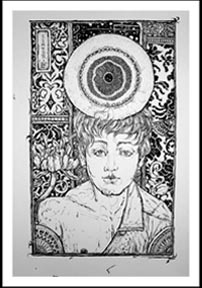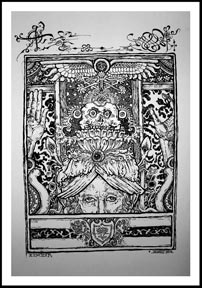Spectres of Mnemosyne
June 4 - 24, 2012Blanc Gallery
Unit 2-E Crown Tower, 107 HV dela Costa St., Salcedo Village, Makati City
SPECTRE ACCORDING TO NIETZSCHE
18 x 12 inches
Ink on water color paper
2012
18 x 12 inches
Ink on water color paper
2012
SPECTRE OF PLEROMA
18 x 12 inches
Ink on water color paper
2012
THE SPECTRE OF ORPHEUS
18 x 12 inches
Ink on water color paper
2012
IN his first exhibition in 2010 (read my review of that show here), Gromyko Semper was both iconoclast and aniconist in his parodying and mocking icons of religion (especially Roman Catholic) and (especially religious) history. But perhaps cognizant of the fact that a parody of any sort of iconography qua a socio-political act necessarily manufactures an alternative system of iconography (iconoclasm/aniconism as its own iconography), opening thus itself to a counter-visual criticism of its visual criticism, Semper now turns to explore iconoclasm’s other option—postmodernism’s self-questioning and self-flagellating embrace of semiotics’ Marxist denouncement of both icon- and iconoclastic-touting.
In his new works, Semper—in his usual woodcut-looking large drawings—takes off inspired by the art of Ukiyo-e and Albín Brunovský. (The drawings are teamed with responses in poetry by American poet William Nace, Jr. Nace’s postmodern poems likewise have a strongly Blakean flavour, heavily peppered with surrealism, Dada, contemporary music, and ironic mythologies urging a more eclectic Christianity—Nace is a former pastor. These literary poesies decidedly add extra layers of nuance to Semper’s drawings.)
ARMED with new visual takeoff points for composition, Semper came up with what he calls “spectres.” In turn, Semper is also now wont to quote Carl Jung (“Dreams are symbolic in order that they cannot be understood, in order that the wish, which is the source of the dream, may remain unknown.” – Psychology of the Unconscious), . . . when previously he would tend to deny Roland Barthes a chance, choosing instead to go for later Terry Eagleton, with a taste for what Umberto Eco calls the “closed text.” Semper’s more senior friend, the painter Marcel Antonio, had been a sounding board for the certainty/uncertainty of that early proclivity, and the art world now knows that Antonio’s art has always been an appropriation of narrative art’s habits (“manners”) for both their narrative (“closed”) and anti-narrative (“open”) values. Having said all of the above, then, one would find the title of Semper’s present show—in referencing ghosts of memory—as verily spot-on.
Now, looking at the artist’s “portraits of memory” in the show, we’d notice that the characters in these portraits derive from our collective (international) memory of fairy tales, legends, myths, fables and other cosmological sources, each a jumbled child of mnemonics born of this memory’s confused splicing of their sources’ genes, producing thus a new community with its own potential symbology and semiosis almost independent of their parents’ own. With these new creatures, then, Semper transforms the societal Mnemosyne of a universal myth to become a Mnemosyne of the private, almost self-indulgent, ego (the artist’s as well as the viewer’s own reading ego).
This drunk inward contemplation (and embrace) of memories comes in the manner of an occurrence wherein a hundred influences arrive upon it to such a level of simultaneity that one already forgets the specificity of those influences, rendering it thus impossible for the occurrence to properly acknowledge an influence for a specific/distinct virtue. In Semper’s new art, therefore, the public Mnemosyne is appropriated for the production of portraits of self-indulgence, a collection that ultimately spits on emblems and their fixed genes in favor of new visual species, with each creature wallowing in its own secret aspirations and desires, removed—if possible (as per Barthes’ wonderment)—from societal contexts. In the artist’s words describing these new-mnemonic creatures, “they are codices and syntaxes of my ideologies . . . they are what I am and what I am made of.”
Additionally, with this new exploration Semper creates a series of new private icons whose feet nonetheless rest on the ground (“I made them look like icons but I took off the halo they should have had”), like new ideal mongrels of merely self-absorbed, sometimes funny, musings (“I wanted them to be ‘fernal’, as opposed to infernal, that is to say of this world and part of it”). Portraits these are, therefore, not of our respective selves as physical figures of vanity for social consideration and awe but of our respective inner selves as “mnemosynes” of honesty.
Building thus these new alternative icons instead of scolding old ones, Semper engineers a new democracy of iconographies, which democracy and vouching for the private memory could be the better weapon against any iconography’s bigotry and consequent authoritarianism.
— May 20, 2012



No comments:
Post a Comment